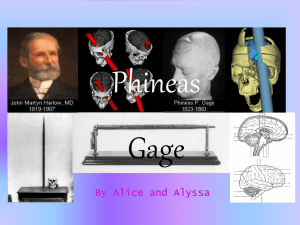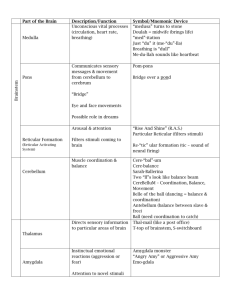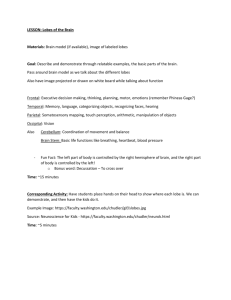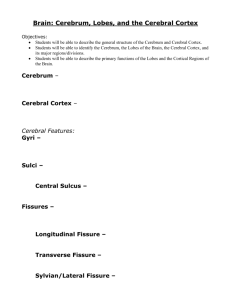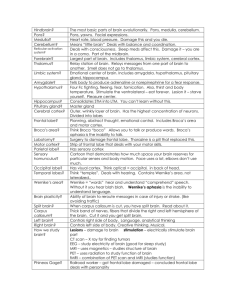Powerpoint
advertisement
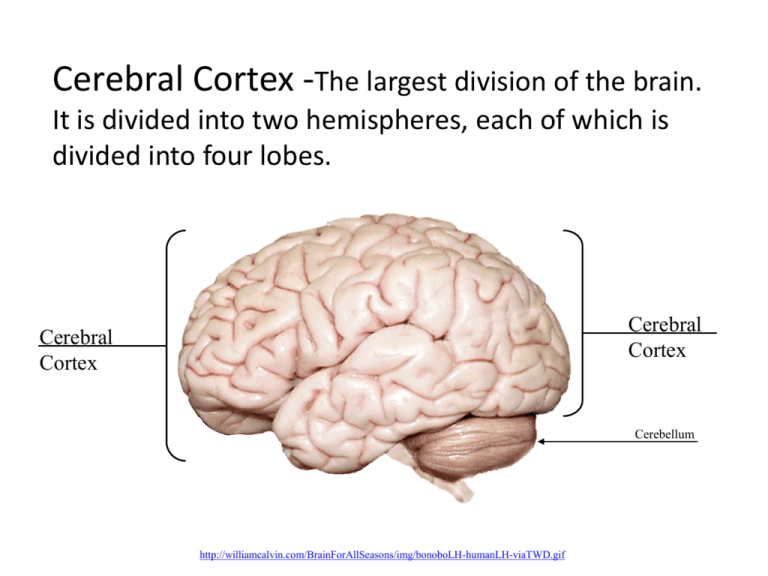
Cerebral Cortex -The largest division of the brain. It is divided into two hemispheres, each of which is divided into four lobes. Cerebral Cortex Cerebral Cortex Cerebellum http://williamcalvin.com/BrainForAllSeasons/img/bonoboLH-humanLH-viaTWD.gif Lobes of the Brain (4) • • • • Frontal Parietal Occipital Temporal http://www.bioon.com/book/biology/whole/image/1/1-8.tif.jpg Cerebral Cortex (lobes) Divided into 4 lobes: Frontal: motor function, motivation, aggression, smell and mood Parietal: reception and evaluation of sensory info. Temporal: smell, hearing, memory and abstract thought Occipital: visual processing Specific Sulci/Fissures: Central Sulcus Longitudinal Fissure Sylvian/Lateral Fissure Transverse Fissure http://www.bioon.com/book/biology/whole/image/1/1-8.tif.jpg http://www.dalbsoutss.eq.edu.au/Sheepbrains_Me/human_brain.gif Cerebral Features: • Gyri – Elevated ridges “winding” around the brain. • Sulci – Small grooves dividing the gyri – Central Sulcus – Divides the Frontal Lobe from the Parietal Lobe • Fissures – Deep grooves, generally dividing large regions/lobes of the brain Frontal Lobe - Cortical Regions • Prefrontal Cortex – Cortical region involved in planning complex cognitive behavior, personality expression, decision making, and moderating social behavior. • Premotor Cortex – Contributes to motor functions • Primary Motor Cortex – Cortical site involved with controlling movements of the body. • Broca’s Area – Controls facial neurons, speech, and language comprehension. Located on Left Frontal Lobe. – Broca’s Aphasia – Results in the ability to comprehend speech, but the decreased motor ability (or inability) to speak and form words. Lobes of the Brain - Frontal • The Frontal Lobe of the brain is located deep to the Frontal Bone of the skull. • It plays an integral role in the following functions/actions: - Memory Formation - Emotions - Decision Making/Reasoning - Personality Modified from: http://www.bioon.com/book/biology/whole/image/1/1-8.tif.jpg Lobes of the Brain - Parietal Lobe Somatosensory cortex: • It plays a major role in the following functions/actions: - Senses and integrates sensation(s) - Spatial awareness and perception (Awareness of body/ body parts in space and in relation to each other) Modified from: http://www.bioon.com/book/biology/whole/image/1/1-8.tif.jpg Lobes of the Brain – Temporal Lobe • Primary Auditory Cortex • Play an integral role in the following functions: - Hearing - Organization/Comprehension of language - Information Retrieval (Memory and Memory Formation) Modified from: http://www.bioon.com/book/biology/whole/image/1/1-8.tif.jpg Temporal Lobe – Cortical Regions • Wernicke’s Area – Language comprehension. Located on the Left Temporal Lobe. - Wernicke’s Aphasia – Language comprehension is inhibited. Words and sentences are not clearly understood, and sentence formation may be inhibited or non-sensical. Primary Auditory Cortex Wernike’s Area Primary Olfactory Cortex (Deep) Conducted from Olfactory Bulb Modified from: http://www.bioon.com/book/biology/whole/image/1/1-8.tif.jpg Regions Lobes of the Brain – Occipital Lobe • Its primary function is the processing, integration, interpretation, etc. of VISION and visual stimuli. • Primary Visual Cortex – This is the primary area of the brain responsible for sight recognition of size, color, light, motion, dimensions, etc. Modified from: http://www.bioon.com/book/biology/whole/image/1/1-8.tif.jpg Primary Visual Cortex Visual Association Area Modified from: http://www.bioon.com/book/biology/whole/image/1/1-8.tif.jpg Regions The strange case of Phineous Gage Phineous Gage • • • • Railroad foreman Well-respected, hard-working 1848: tamping iron accident He never lost consciousness, and had no obvious neurological symptoms • But he was “no longer Gage” Phineas Gage “the powder exploded, carrying an iron instrument through his head an inch and a fourth in circumference, and three feet and eight inches in length, which he was using at the time. The iron entered on the side of his face, shattering the upper jaw, and passing back of the left eye, and out at the top of the head. The most singular circumstances connected with this melancholy affair is, that he was alive at two o’clock this afternoon, and in full possession of his reason, and free from pain.” – from Free Soil Union, September 1948 Phineous Gage Gage’s Doctor described Gage’s post-accident personality as: “Fitful, irreverent, indulging at times in the greatest profanity which was not previously his custom, manifesting but little deference for his fellows, impatient of restraint and advice when it conflicts with his desires, at times pertinaciously obstinate, yet capricious and vacillating, devising many plans of future operation, which are no sooner arranged than they are abandoned … a child in his intellectual capacity and manifestations, he has the animal passions of a strong man.” Brain Anatomy - Phineas Gage •Personality changed – Gage became crude, uncaring, impulsive, irrational, anti-social •Ventromedial region of the frontal lobes on both sides - causing a defect in rational decision making and the processing of emotion “The equilibrium or balance between his intellectual faculties and animal propensities, seems to have been destroyed.” (Former R.R. Employer) “He was no longer Gage…” • Several different angles of where the rod passed through his skull Some symptoms associated with frontal lobe damage •Working memory deficits •Temporal memory / Source memory •Perseveration •Loss of spontaneous behavior •Apathy •Planning deficits/impaired goal-directed behavior •Disinhibition/impulsive behavior •Impaired attention •Depression •Elevated mood Mood/Affect/Emotion Symptoms • Depression • Mood elevation • Apathy Frontal Lobotomies • 1935: chimps who were neurotic before surgery became more relaxed after it • 1930s: Egaz Moniz begins frontal lobotomies in humans (and eventually wins Nobel Prize) • 1950s: psychosurgery in vogue; 40,000 frontal lobotomies in North America • The story of Agnes (Kolb & Whishaw) – no outward signs of emotion – no facial expression – no feelings toward other people (but still liked her dog) – felt empty, zombie-like – Other patients lose prosody = emotional component of speech • orbitofrontal cortex – Patients with damage can remember info but don’t have emotions associated with it Frontal Lobe Lobotomy: Early Critisicms Hoffman (1949) – "these patients are not only no longer distressed by their mental conflicts but also seem to have little capacity for any emotional experiences - pleasurable or otherwise. They are described by the nurses and the doctors, over and over, as dull, apathetic, listless, without drive or initiative, flat, lethargic, placid and unconcerned, childlike, docile, needing pushing, passive, lacking in spontaneity, without aim or purpose, preoccupied and dependent." Frontal Lobe Frontal Lobe Damage • May have normal IQ on standard tests • Poor control: reasoning, planning & emotions – Disinhibition: poor control of emotions • Poor mental flexibility – Perseveration: e.g. trouble stopping action once initiated, e.g. dialing 999. • Frontal lobe modulates functions of other regions




